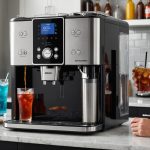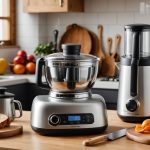Understanding Water Filtration Systems
The water filtration systems available today cater to a variety of needs, from improving kitchen health to ensuring environmentally sustainable practices. Understanding the different types can guide consumers in making optimal choices. Reverse osmosis systems are known for their ability to remove a wide range of contaminants by pushing water through a semi-permeable membrane. This type is particularly valued for removing dissolved solids and chemicals, contributing to improved health benefits.
Another popular option is activated carbon filtration, which excels in removing chlorine, radon, and volatile organic compounds. It’s effective at enhancing the taste and smell of water, which indirectly promotes increased water consumption and, consequently, better hydration. These filters are favoured for both their cost-efficiency and minimal environmental impact since they reduce the need for bottled water.
Also to discover : Global Flavor Fusion: Crafting a Culturally-Inspired Kitchen for Diverse Culinary Experiences
Investing in a water filtration system offers not only health perks, such as reduced exposure to harmful contaminants but also economic benefits by potentially lowering water purchase costs over time. Additionally, using such systems supports eco-friendly habits by diminishing plastic waste. Exploring the benefits of water filtration reveals how easily they integrate into daily kitchen routines, providing both health and environmental advantages.
Step-by-Step Installation Guide
Installing a water filtration system yourself can be a rewarding endeavor, ensuring both cost savings and a personalised setup. Whether you’re embarking on this as a DIY installation project or simply curious, this step-by-step guide is crafted to simplify the process.
Topic to read : Key Features of a Whisper-Quiet Dishwasher Perfect for Open Concept Kitchens
Tools and Materials Needed
Before initiating the installation, gather essential tools such as an adjustable wrench, screwdriver set, pipe cutter, and Teflon tape. The specifics may vary based on whether you’re installing a reverse osmosis or an activated carbon system. Ensure you have the filtration kit’s instructions, as components may differ.
Preparing Your Kitchen for Installation
Preparation is crucial. Begin by clearing the area under the sink, ensuring easy access to plumbing lines. It may be useful to disconnect the water supply and have towels nearby to manage potential leaks. For some systems, drilling a hole in your sink or countertop might be necessary for dispensing faucets.
Installing the Filtration System
Follow the manufacturer’s instructions closely. Generally, it involves attaching adapters to plumbing, connecting the system’s intake, and securing the filter under the sink. Double-check all connections for leaks, and perform a test run to ensure functionality. If needed, consult additional resources or seek professional assistance to fine-tune the installation.
Troubleshooting Common Installation Issues
When installing water filtration systems, users may encounter several common problems. Understanding these issues and knowing how to troubleshoot them can ensure a smoother DIY installation process.
Identifying Common Issues
One prevalent issue is leakage at connection points. Often, this results from improper sealing or incorrect fitting sizes. To address this, ensure all connections are tightly secured using Teflon tape to prevent leaks. Another frequent problem is low water pressure, which might be due to a clogged filter or kinked hoses. Inspect and replace filters regularly, and verify that all hoses are straight and unobstructed.
Solutions to Rectify Installation Problems
In instances where the water flow is intermittent or non-existent, it could be due to an airlock in the system. Bleeding the system by opening all faucets for a short period can resolve this. Additionally, ensure that the inlet valve is fully open. If you’re unsure about any step, consulting the manufacturer’s instructions can provide much-needed clarity.
Tips for Optimal Performance
Perform a test run post-installation to identify any issues immediately. Always refer to the step-by-step guide included with your kit for the most accurate troubleshooting steps. Regular maintenance checks can avert many potential problems, leading to sustained effectiveness of your water filtration system.
Maintenance of Your Water Filtration System
Maintaining water filtration systems is essential for their longevity and performance. Routine tasks ensure efficient operation and safeguard your family’s health.
Routine Maintenance Tasks
Regular upkeep involves checking for potential leaks, as these may indicate loose connections. Periodically inspect pipes and connections to prevent any mishaps. Some systems require flushing to avoid build-up in water filters, ensuring they function optimally.
When to Replace Filters
Knowing when to replace filters is vital for maintaining their efficacy. Typically, carbon filters should be changed every three to six months, while reverse osmosis membranes last longer, from two to five years, depending on usage. Filter replacement ensures your water remains clean and safe for consumption.
Signs Your System Needs Attention
There are telltale signs that your water filtration system may need servicing. A noticeable decline in water pressure can be an indicator of clogged filters. If you detect an unusual taste or odour in your water, it’s time to check for issues. Address these signs promptly to prevent further complications and to maintain the system’s life.
By embracing a proactive approach towards water filter maintenance, you safeguard your investment, keep your kitchen healthy, and enhance the benefits of water filtration.
Health Benefits of Filtered Water
Filtered water offers significant benefits by enhancing drinking water safety and contributing to improved overall hydration. Many tap water sources contain contaminants such as lead, chlorine, and bacteria. These impurities can potentially pose health risks, particularly for individuals with weakened immune systems. By utilising a water filtration system, these harmful substances are effectively reduced, providing cleaner and safer water for consumption.
Consuming filtered water directly correlates with numerous health advantages. These range from improved digestion to a reduced risk of gastrointestinal issues, as harmful chemicals and bacteria are eliminated. Moreover, filtering water can enhance taste and eliminate odour, promoting an increased intake of water and consequently improving hydration levels. Proper hydration aids in maintaining energy levels, cognitive function, and skin health, playing a crucial role in overall well-being.
Filtered water stands as a pivotal factor in maintaining optimal health. Water filtration systems ensure that you’re not only safeguarding against potential contaminants but also encouraging a healthier lifestyle by supporting increased water consumption and better hydration habits. By choosing to drink filtered water, you prioritise both immediate and long-term health.
Comparison of Different Water Filtration Systems
When selecting water filtration systems, understanding their comparison is crucial for making an informed decision. Each type offers unique benefits, and evaluating them helps align with specific needs and budgets.
Overview of Popular Brands
Several brands stand out in the water filtration market. Systems like Brita and Pur are renowned for effective activated carbon filtration, ideal for improving taste and removing basic contaminants. Culligan and Aquasana provide advanced models with multi-stage filtration, often integrating reverse osmosis for comprehensive contaminant removal, catering to those prioritizing thorough water purification.
Cost Analysis
There’s a notable price spectrum among filtration systems. Basic pitcher filters from brands like Brita offer affordability, typically under £30. In contrast, high-performance models from Culligan can range from £150 to £500, reflecting their enhanced filtration capabilities and longevity. Balancing cost against the benefits of contaminant removal and health improvements is vital.
Performance Metrics
Performance efficacy varies across systems. Reverse osmosis systems score high on removing dissolved solids and chemicals, whereas activated carbon excels in enhancing water taste and reducing chlorine. Customer reviews frequently highlight both systems’ role in promoting kitchen health by mitigating harmful substances, affirming their value in ensuring safe and pleasant drinking water.
Frequently Asked Questions
Navigating water filtration FAQs can clear up common uncertainties and empower consumers to make informed decisions about their water quality.
Do water filtration systems remove all contaminants?
While most systems are highly effective, no system removes all contaminants. Reverse osmosis systems excel at filtering dissolved solids, like heavy metals, while activated carbon targets chemicals like chlorine. Understanding each system’s strengths helps in choosing the right filtration method tailored to specific needs.
What is the difference between filtered and unfiltered water?
Filtered water generally offers improved drinking water safety compared to unfiltered water. It reduces exposure to contaminants such as lead and bacteria, promoting better hydration and overall health. Increased water quality through filtration supports kitchen health by ensuring clean cooking and drinking water.
Are there regulations for home water filtration systems?
Yes, various regulations and standards exist. For instance, NSF International and the Environmental Protection Agency (EPA) oversee testing of water filtration systems. These organizations ensure that systems effectively improve water quality and are suitable for consumer use.
Understanding these FAQs enhances consumer knowledge and ensures better water quality decisions, promoting health and safety in daily life.
Recommended Products for Kitchen Water Filtration
Choosing the best water filtration systems for your kitchen can significantly impact health and convenience. Numerous options exist catering to various needs and budgets, ensuring optimal safety and taste in your drinking water.
Top Picks for Home Use
A few standout products in the market are recognised for their effectiveness. Models like the iSpring RCC7 deliver sturdy performance with reverse osmosis, ensuring comprehensive contaminant removal, offering peace of mind for health-conscious households.
Budget-Friendly Options
Affordable solutions are available that maintain quality without a hefty price tag. Brita’s Basic Faucet Filter System delivers effective filtration at a lower price, efficiently reducing lead and other common water impurities. This budget-friendly choice is suitable for those looking to enhance kitchen health progressively.
High-End Choices
For those ready to invest in advanced technology, high-end systems like Aquasana’s OptimH2O offer multi-stage filtration, integrating both reverse osmosis and activated carbon. These premium models provide top-tier water quality, crucial for households prioritising the benefits of water filtration.
Selecting an appropriate system from these recommendations can significantly improve your water’s quality, assuring you are well-equipped to prioritise health and sustainability.





